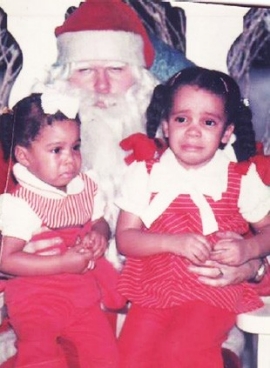He may or may not have mowed down your grandmother with reindeer on the way to your home. He may or may not be waiting for your mother underneath the mistletoe.
For some children, the idea of Santa Claus isn’t met with a festive outpouring of glee, but rather an outpouring of tears.
According to Valérie De Courville Nicol, a professor in the Department of Sociology and Anthropology, being unsettled by an encounter with a hoary, velvet-cloaked man isn’t unusual for small children.
“Just because in an adult’s or older kid’s mind there's an association between the figure of Santa and happiness doesn't mean those emotional associations are present in young children. Clearly in many cases, they're not,” says De Courville Nicol.
De Courville Nicol says that Santa’s permanent jollity and unusual attire may be part of what makes him so scary, especially for those under the age of four.
“The fear of Santa is similar to the fear of clowns, in the sense that he exaggerates or dramatizes normal characteristics, forms of appearance and emotions, drawing them to an extreme,” says De Courville Nicol. “For some children that's a violation of what they know of what is normal and familiar, and causes them to feel threatened.”
De Courville Nicol notes that while more often than not Father Christmas is constructed as a rewarding figure, for some children he might come across as a punitive deity.
“That he draws up a list, he’s always watching to make sure we’re not doing bad things, this could lead to him being perceived by some as a disciplinary figure,” says De Courville Nicol. “It's a displacement of parental authority onto a mythical figure.”
So how does one deal with a child who’s suffering from a serious case of Claus-trophobia?
De Courville Nicol says that, like anything, it’s a process. And while the notion that exposure may help people to overcome their fears, forcing a kid to sit on a mall Santa’s lap probably won’t help.
“While it’s something that is important within our culture, to have our children experience Santa positively, I think that some parents confuse their own needs with their children's needs,” says De Courville Nicol. “There isn't much point at that age in forcing an experience if it’s an unpleasant, even terrifying, one.”
De Courville Nicol says that with time, patience and reassurance, most children who are afraid of Santa will overcome their aversion.
Share your favourite scared-kid Santa photo on Concordia's Instagram account with the hashtag #hohohorrified.
 Concordian Karen Gregg and her sister Samantha Patricia were less than impressed with their Santa experience...
Concordian Karen Gregg and her sister Samantha Patricia were less than impressed with their Santa experience...